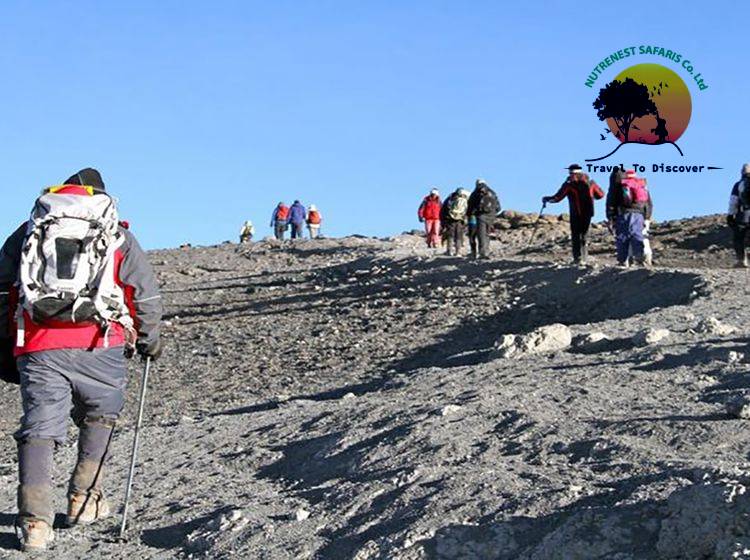The detailed Itinerary
The following itinerary is for six days; those on a seven-day trek will, more often than not, spend a night at Karanga at the end of Day 4
Day 1: Machame Gate To Machame Huts/Camp
Your adventure begins immediately after breakfast at around 8am when you are picked up by Nature nest cars from your place of accommodation and take you to Machame Gate (1828m), for registration. The first day of the trek takes you into the forest bearding Kilimanjaro’s lower slopes. It’s quite a sweaty uphill walk of 10.5km. Expect to see a variety and plenty of unique flora along the trek on this Route. Expect to also see colobus and blue monkey, and possibly other creatures of the forest. You will also have a lunch break while in the forest.
At the end of the day, reach the upper limit of the forest and the Machame Camp (3032m), with views over the treetops to the plains below
Day 2: Machame Camp To Shira Cave
The second day involves a unique hike as you leave the forest behind to plough through Kilimanjaro’s second vegetation zone, the heath and moorland. There are four of these zones on the mountain. This is why some people say that the climb is like walking through four different seasons in a week.
Early on this day, you will catch your first glimpse of Kibo, Kilimanjaro’s famed, snowy summit and your ultimate destination. Mount Meru, Kilimanjaro’s nearest neighbour, is also visible during today’s trek. You will notice that you will be setting a deliberately slow pace from today onwards, to help everyone acclimatize to the thinning air.
In about an hour’s time after lunch, the gradient levels out slightly as you approach the Shira Plateau whereby you will find flora such as groundsels and weird lobelias adorn the plateau.
The overnight stay in tents is at Shira Cave Campsite with a meal to follow. There are views across the plateau towards Kibo as well as towards Kili’s third summit, Johnsell Point
Day 3: Shira Cave To Barranco Camp/Huts
The morning begins with a lengthy crossing of the plateau as you head due east towards Kibo. It’s a long walk but a photogenic one, with Kilimanjaro’s snowy summit a constant presence ahead.
At this time, lunch is taken near the Lava Tower, at the foot of Kibo. Get ready to head into some serious altitude, with Lava Tower standing at 4530m above sea level. For this reason, it is normal for people to have a slight headache when they finally reach the campsite for the evening that is, Barranco Camp, following a steep descent to 3986m. This is entirely normal, and only worrying if the symptoms persist.
By way of compensation, Barranco is the most interesting campsite on the route, set amongst a grove of senecio hard against the south face of Kibo. It is, however, also very busy. Snacks and then dinner is served in the evening
Day 4: Barranco Camp To Barafu Camp/Huts Via Karanga Valley
This long day begins with the steepest section of the entire trek as you will spend the first hour climbing the Breakfast Wall. From here the path meanders down across valleys and slopes traversing the southern slopes of Kibo. A steep drop then leads you to the floor of the flora-rich Karanga Valley (4034m above sea level and 5.1km from Barranco Campsite). Though your destination for lunch shares its name with this beautiful valley, it actually lies a stiff 20- minute climb up the opposite side.
You will have lunch at Karanga Valley Campsite while enjoying the views north towards and the southern face of Kibo. This hopefully will distract trekkers from any ill effects that you may be feeling because of the altitude. A short afternoon follows (3.4km) as you traverse the southern side of Kibo, walking through a spectacular lunar landscape.
Climbing onto a ridge, you will reach chilly Barafu Camp (4662m) on the south-eastern shoulder of Kibo. Here you will have a relaxation, take both lunch and dinner, and try to get some sleep before the rigours of the night ahead of you
Day 5: Barafu Camp/Huts To Summit And Descent To Mweka Camp/Huts
After an early wake up at around midnight, you will begin your slow movement up to Stella Point (5745m) on the edge of the Kibo crater. It’s a steep, slow, cold movement and a test of your endurance: once you reach this point, expect to receive the Kilimanjaro certificates.
From Stella Point it is a mere 45 minutes further on, past glaciers and snowfields and with views over the Kibo Crater, to Uhuru Peak at 5895m the highest point in Africa. At this juncture if you are on time, you can watch the sun rise over the African continent, take photos and have a relaxation.
After a rest at the top, continue back down to Barafu Camp. It’s a walk that is considerably quicker than it was on the way up. At Barafu, you will take your breakfast and relax for an hour. The walk takes you back down through the alpine desert, heath and moorland zones until you once more enter the forest zone via Millennium Camp (3827m). Furthermore as you slop down amongst the trees, you will find the Mweka Campsite (3106m), your final stop on the trek.
Day 6: Mweka Camp/Huts To Mweka Gate
It’s just a couple of hours further now from the campsite to Mweka Gate (1633m). At the gate, those who made it to the summit or Stella Point will collect their certificates. A car will be waiting to return you back to your hotel and after that, you will have a warm shower and cold beers thus end of your trek
